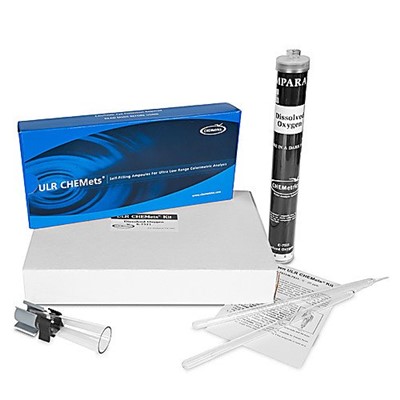Return to previous page
Dissolved Oxygen Rhodazine Refill Kit
Item #: TMS/9866E71
Manufacturer: Northwest Scientific Inc.
Supplier #: 9866E71
CHEMetrics Part No. R-7540
The level of dissolved oxygen in natural waters is often a direct indication of quality, since aquatic plants produce oxygen, while microorganisms generally consume it as they feed on pollutants. At low temperatures the solubility of oxygen is increased; during summer, saturation levels can be as low as 4 ppm. Dissolved oxygen (D.O.) is essential for the support of fish and other aquatic life and aids in the natural decomposition of organic matter. Waste treatment plants that employ aerobic digestion must maintain a level of at least 2 ppm dissolved oxygen. At elevated temperatures, oxygen is highly corrosive to metals, causing pitting in ferrous systems such as high-pressure boilers and deep well oil recovery equipment. To prevent costly corrosion damage, the liquids in contact with the metal surfaces must be treated, usually by a combination of physical and chemical means. Deaeration can reduce the dissolved oxygen concentration of boiler feedwater from several ppm to a few ppb. Chemical reducing agents such as hydrazine, DEHA, or sodium sulfite, may be used instead of or in conjunction with deaeration. The Indigo Carmine Method References: ASTM D 888-87, Dissolved Oxygen in Water, Test Method A. Gilbert, T. W., Behymer, T. D., Castañeda, H. B., "Determination of Dissolved Oxygen in Natural and Wastewaters," American Laboratory, March 1982, pp. 119-134. Test kits for environmental and drinking water applications (ppm range) employ the indigo carmine method. The reduced form of indigo carmine reacts with D.O. to form a blue product. The indigo carmine methodology is not subject to interferences from temperature, salinity, or dissolved gases such as sulfide, which plague users of D.O. meters. Results are expressed as ppm (mg/L) O2. The Rhodazine D™ Method References: Developed by CHEMetrics, Inc. ASTM Power Plant Manual, 1st. ed. p. 169 (1984). ASTM D 5543-15, Low Level Dissolved Oxygen in Water. Department of the Navy, Final Report of NAVSECPHILADIV Project A - 1598, Evaluation of CHEMetrics Feedwater Dissolved Oxygen Test Kit (1975). Test kits for boiler waters and applications requiring trace levels of D.O. (ppb range) employ the Rhodazine D methodology. Developed by CHEMetrics, Inc., and approved by ASTM as the reference method for ppb D.O. determination, the Rhodazine D compound in reduced form reacts with dissolved oxygen to form a bright pink reaction product. The method is not subject to salinity or dissolved gas interferences. Oxidizing agents, including benzoquinone, can cause high results. Reducing agents such as hydrazine and sulfite do not interfere. Results are expressed as ppm (mg/L) or ppb (ug/L) O2. Low-range dissolved oxygen test kits include a special sampling tube for use with boiler feedwater. This device allows the user to break the tip of the ampoule in a flowing sample stream in order to preclude error from contamination by atmospheric oxygen.
The level of dissolved oxygen in natural waters is often a direct indication of quality, since aquatic plants produce oxygen, while microorganisms generally consume it as they feed on pollutants. At low temperatures the solubility of oxygen is increased; during summer, saturation levels can be as low as 4 ppm. Dissolved oxygen (D.O.) is essential for the support of fish and other aquatic life and aids in the natural decomposition of organic matter. Waste treatment plants that employ aerobic digestion must maintain a level of at least 2 ppm dissolved oxygen. At elevated temperatures, oxygen is highly corrosive to metals, causing pitting in ferrous systems such as high-pressure boilers and deep well oil recovery equipment. To prevent costly corrosion damage, the liquids in contact with the metal surfaces must be treated, usually by a combination of physical and chemical means. Deaeration can reduce the dissolved oxygen concentration of boiler feedwater from several ppm to a few ppb. Chemical reducing agents such as hydrazine, DEHA, or sodium sulfite, may be used instead of or in conjunction with deaeration. The Indigo Carmine Method References: ASTM D 888-87, Dissolved Oxygen in Water, Test Method A. Gilbert, T. W., Behymer, T. D., Castañeda, H. B., "Determination of Dissolved Oxygen in Natural and Wastewaters," American Laboratory, March 1982, pp. 119-134. Test kits for environmental and drinking water applications (ppm range) employ the indigo carmine method. The reduced form of indigo carmine reacts with D.O. to form a blue product. The indigo carmine methodology is not subject to interferences from temperature, salinity, or dissolved gases such as sulfide, which plague users of D.O. meters. Results are expressed as ppm (mg/L) O2. The Rhodazine D™ Method References: Developed by CHEMetrics, Inc. ASTM Power Plant Manual, 1st. ed. p. 169 (1984). ASTM D 5543-15, Low Level Dissolved Oxygen in Water. Department of the Navy, Final Report of NAVSECPHILADIV Project A - 1598, Evaluation of CHEMetrics Feedwater Dissolved Oxygen Test Kit (1975). Test kits for boiler waters and applications requiring trace levels of D.O. (ppb range) employ the Rhodazine D methodology. Developed by CHEMetrics, Inc., and approved by ASTM as the reference method for ppb D.O. determination, the Rhodazine D compound in reduced form reacts with dissolved oxygen to form a bright pink reaction product. The method is not subject to salinity or dissolved gas interferences. Oxidizing agents, including benzoquinone, can cause high results. Reducing agents such as hydrazine and sulfite do not interfere. Results are expressed as ppm (mg/L) or ppb (ug/L) O2. Low-range dissolved oxygen test kits include a special sampling tube for use with boiler feedwater. This device allows the user to break the tip of the ampoule in a flowing sample stream in order to preclude error from contamination by atmospheric oxygen.


